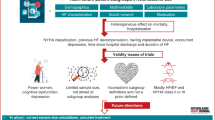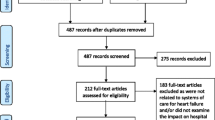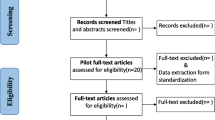Abstract
Introduction: Heart failure (HF) is a serious public health problem that affects many individuals and is associated with high mortality and multimorbidity. It is estimated that the prevalence of heart failure in mainland Portugal will increase by 30% in 2035 and 33% in 2060. Home care for people with heart failure using monitoring devices and/or integrated into telemonitoring programs has been the object of research by the scientific community in health. Objective: We aim to identify and analyze if the implementation of a telemonitoring program contributes to self-care and quality life in management of the clinical situation. Methods and analysis: This is a systematic literature review protocol. The search will be carried out in the following databases CINAHL Complete, MEDLINE Complete, Nursing & Allied Health Collection: Comprehensive, Cochrane Central Register of Controlled Trials, Cochrane Database of Systematic Reviews, Cochrane Methodology Register, Library, Information Science & Technology Abstracts, MedicLatina, Cochrane Clinical Answers The research strategy contains the following terms MeSH or similar. Two independent revisers will perform the inclusion and exclusion criteria analysis, the quality analysis of the data, and its extraction for synthesis. Disagreements will be resolved by a third revisor. Studies using telemonitoring intervention strategies in patients with heart failure at home and what is the relationship with self-care and quality of life of the person will be included.
Access provided by Autonomous University of Puebla. Download conference paper PDF
Similar content being viewed by others
Keywords
1 Introduction
Heart failure affects about 1–2% of the world's population and 6–10% of individuals over 65 years of age [1, 2]. These data are convergent with other studies that report that the prevalence of the disease varies between 1.5% and 4% of the population in developed countries [3]. The report “Portugal - Cardio and cerebrovascular diseases in numbers 2015” indicates that heart failure is the second disease with the highest number of hospitalizations in our country [4]. Due to decompensation of heart failure, about 25% of people end up dying and about 40% are readmitted to hospital units at least once a year [5]. The key to avoiding decompensation of the disease, involves recognizing the signs of clinical deterioration, often with monitoring by a healthcare team [6]. They point out that the interventions of professionals in education, health promotion and self-care are fundamental for the person to develop the ability to manage their own disease at home [7].
Thus, self-care is a process of maintaining the patient's health, through its promotion and management of the clinical condition, and is an excellent tool which allows for a more adequate management of this chronic disease [8]. The nurses’ contribution to the promotion and maintenance of self-care should be well planned and implemented, with greater importance in periods of greater vulnerability.[9] The experiences with the disease, the way it manifests itself and how it develops are a complex management process that influences the patient's life and quality of life. It is essential to develop health strategies that seek to mitigate the effects that this chronic disease causes. Home care associated with telemonitoring programs may be strategies to consider. [8].
Home care is a form of intervention in chronic disease management, integrating patient-centered nursing care, ensuring continuity of support and is one of the most significant aspects in the care needs of patients/families with heart failure [10]. The implementation of digital health programs, as an innovative and global strategy, is recommended by the WHO [11]. Telemonitoring is a tool with high potential, it is defined as the use of technologies to perform person monitoring remotely. The use of telemonitoring data is important for the patient's own use in maintaining self-care or through the integration of the care process defined by the healthcare team. [8, 12, 13, 13].
The subject has been studied by several authors, but there still seem to be some gaps in knowledge. This systematic literature review aims to identify whether the health care provided to patients with heart failure integrated in telemonitoring programs interferes with the patient's self-care ability and quality of life [14,15,16,17,18].
2 Objective
We aim to identify and analyze if the implementation of a telemonitoring program contributes to self-care and management of the clinical situation.
3 Review Question
What are the health gains in terms of promoting self-care behavior, resulting from the use of a telemonitoring device (for a period of 0 to 6 months), for people with heart failure at home?
4 Methods and Analysis
This protocol was developed according to the Preferred Reporting Items for Systematic Reviews and Meta-Analyses (PRISMA) Protocols Statement [18] It was registered with the International Prospective Register of Systematic Reviews PROSPERO registration number: CRD42022303773.
We chose to include in this review, studies conducted with resources using quantitative, qualitative, mixed methodologies and theoretical approaches.
This protocol was developed in July 2022, and it is intended that the respective review be completed by the end of January 2023.
4.1 Eligibility Criteria
The way to guarantee the rigor and systematization specific to this type of study, eligibility criteria were defined as follows.
Population
The population included in the study will be adults diagnosed with heart failure who participate in a telemonitoring program.
Intervention
The current literature review will include studies on: (i) the assessment of self-care of people diagnosed with heart failure integrated in a telemonitoring program; (ii) the assessment of the quality of life of people diagnosed with heart failure integrated in a telemonitoring program.
Comparison
Studies with or without comparative groups will be included in this review.
Primary Outcome
The main outcomes considered in this review will be the level of self-care and quality of life of patients with heart failure integrated in a telemonitoring program.
Secondary Outcomes
Secondary outcomes are related to disease management as reflected by number of emergency department visits and number of hospital admissions for disease decompensation.
Study Design
This systematic review shall include empiric quantitative observational or experimental primary studies.
4.2 Search Strategy
Data Sources
In the research strategy, it is intended to carry out a comprehensive bibliographic search and the databases to be consulted will be: CINAHL Complete, MEDLINE Complete, Nursing & Allied Health Collection: Comprehensive, Cochrane Central Register of Controlled Trials, Cochrane Database of Systematic Reviews, Cochrane Methodology Register, Library, Information Science & Technology Abstracts, MedicLatina, Cochrane Clinical Answers.
Search Terms
The research will include the combination of four key concepts according to Medical Subject Headings (MeSH). In this case, the search phrase could be the following: Self-care AND quality of life AND heart failure AND Telemonitoring. Other keywords can also be used if necessary, such as patient e-health, domiciliary care.
The research strategy will be adapted in accordance with each data bank and will be restricted to the last 5 years, i.e., from 2017 to July 2022 in the English, Portuguese and Spanish.
4.3 Data Collection and Analysis
Studies Selection
The following study of research in each database will be exported into Mendeley and the duplicates will be removed. To minimize bias, two reviewers will independently assess the inclusion of the studies by reading the title, abstracts, and keywords and excluding those that do not fit the inclusion criteria in this review. The third reviewer should be consulted in case of disagreements or doubts. Afterward, we proceed to the assessment of the complete texts. To present this selection process, the PRISMA flowchart will be presented with the triage results in its different stages.
Data Extraction
After electronic searching, the records will be moved to EndNote software and the duplicated articles will be excluded automatically and we will remove them manually as well. Titles and abstracts of studies retrieved will be screened independently by two review authors to identify studies that potentially meet the inclusion criteria outlined above. The full text of these potentially eligible studies will be retrieved and independently assessed for eligibility by four review team members. Any disagreement between them over the eligibility of studies will be discussed until you reach consensus. A flow diagram will be used to summarize the study selection process.
Strategy for Data Synthesis
Since it is a systematic review that will include studies with different methodologies, the synthesis and analysis of the results will be narrative in nature, structured to answer the research question posed.
Ethics and Dissemination
Since only the data considered secondary will be analyzed, the ethical approval of this study is not necessary. This scientific paper is a systematic review protocol, in which the data has not yet been extracted or analyzed. The results will be disseminated through publications subject to peer review.
5 Discussion
The research carried out in self-care and quality of life in patients with heart failure has been increasing. Technological development allows for the use of increasingly sophisticated devices that provide support and assistance to people with heart failure.
The studies published do not always show the relationship between disease management through the ability of self-care with telemonitoring support, and how this process influences quality of life. With the development of this protocol, we intend to ensure the accuracy, clarity, and quality of the process so that it is systematic.
Study Limitations
The review will only include studies with quantitative methodology. The languages of research will be English, Portuguese and Spanish.
References
Ponikowski, P., Anker, S.D., AlHabib, K.F., Cowie, M.R., Force, T.L., Hu, S., Filippatos, G.: Heart failure: preventing disease and death worldwide. ESC Heart Failure 1(1), 4–25 (2014). https://doi.org/10.1002/ehf2.12005
Groenewegen, A., Rutten, F.H., Mosterd, A., Hoes, A.W.: Epidemiology of heart failure. Eur. J. Heart Fail 22, 1342–1356 (2020). https://doi.org/10.1002/ejhf.1858
Stretti, L., et al.: A year in heart failure: an update of recent findings. ESC Heart Failure 8, 4370–4393 (2021). https://doi.org/10.1002/ehf2.13760
Ferreira, R.C., et al.: Portugal Doenças Cérebro-Cardiovasculares em Números, 2015. Portugal Doenças Cérebro-Cardiovasculares em Números 2015, 7–90 (2016)
Nakahara-Melo, M., Conceição, A., Cruz, D., & Püschel, V.: Transitional care from the hospital to the home in heart failure: implementation of best practices. Revista Brasileira de Enfermagem, 75 (2021). https://doi.org/10.1590/0034-7167-2021-0123
Taniguchi, C., Okada, A., Seto, N., Shimizu, Y.: How visiting nurses detect symptoms of disease progression in patients with chronic heart failure. Int. J. Qual. Stud. Health Well Being 15(1), 1735768 (2020). https://doi.org/10.1080/17482631.2020.1735768
Brahmbhatt, D., Cowie, M.: Remote management of heart failure: an overview of telemonitoring technologies. Cardiac Fail. Rev. 5(2), 86 (2019). https://doi.org/10.15420/cfr.2019.5.3
Lopes, M.: Desafios de inovação em saúde. Repensar os modelos de cuidados. Imprensa da Universidade de Évora. (2021) https://doi.org/10.24902/uevora.24
Almkuist, K.: Using teach-back method to prevent 30-Day readmissions in patients with heart failure: a systematic review. MedSurg Nursing, 26(5) (2017)
Riegel, B., Jaarsma, T., Strömberg, A.: A middle-range theory of self-care of chronic illness. Adv. Nurs. Sci. 35(3), 194–204 (2012)
World Health Organization. Global strategy on digital health 2020–2025 (2021)
Brito, D.: Remote monitoring of heart failure patients: a complex proximity. Rev. Port. Cardiol. 40(5), 353–356 (2021). https://doi.org/10.1016/j.repc.2021.03.001
Goes, M., Lopes, M., Oliveira, H., et al.: A Nursing Care Intervention Model for Elderly People to Ascertain General Profiles of Functionality and Self Care Needs. Sci Rep 10, 1770 (2020). https://doi.org/10.1038/s41598-020-58596-1
Goes, M., et al.: The Quality of Life of Older Individuals Following the World Health Organization Assessment Criteria. Geriatrics 5, 102 (2020). https://doi.org/10.3390/geriatrics5040102
Goes, M., Lopes, M., Oliveira, H., Marôco, J., Fonseca, C., Santos, M., Caeiro, J.: Psychometric Qualities of a Core Set to Ascertain the Functional Profile of Portuguese Elderly Citizens. In: García-Alonso, J., Fonseca, C. (eds.) IWoG 2019. CCIS, vol. 1185, pp. 314–329. Springer, Cham (2020). https://doi.org/10.1007/978-3-030-41494-8_31
Goes, M., Lopes, M.J., Oliveira, H., Fonseca, C., Mendes, D.: Biological and Socio-Demographic Predictors of Elderly Quality of Life Living in the Community in Baixo-Alentejo, Portugal. In: García-Alonso, J., Fonseca, C. (eds.) IWoG 2018. CCIS, vol. 1016, pp. 319–326. Springer, Cham (2019). https://doi.org/10.1007/978-3-030-16028-9_28
Moher, D., Shamseer, L., Clarke, M., Ghersi, D., Liberati, A., Petticrew, M., Shekelle, P., Stewart, L.A., Group, P.-P: Preferred reporting items for systematic review and meta-analysis protocols (PRISMA-P) statement. Syst. Rev. 2015(4), 2–9 (2015)
Almeida, E., Raimundo, M., Coelho, A., Sá, H.: Incidence, prevalence and crude survival of patients starting dialysis in Portugal (2010–16): analysis of the National Health System individual registry. Clin. Kidney J. 14(3), 869–875 (2021). https://doi.org/10.1093/ckj/sfaa023
Coelho, A., et al.: Mental health patient-reported outcomes and experiences assessment in Portugal. Int. J. Environ. Res. Public Health 19(18) (2022). https://doi.org/10.3390/ijerph191811153
Author information
Authors and Affiliations
Corresponding author
Editor information
Editors and Affiliations
Rights and permissions
Copyright information
© 2023 The Author(s), under exclusive license to Springer Nature Switzerland AG
About this paper
Cite this paper
Pequito, T., Marques, M., Goes, M. (2023). Effects of Telemonitoring in Adult Heart Failure Patients on Self-care and Quality of Life: A Systematic Review Protocol. In: Moguel, E., de Pinho, L.G., Fonseca, C. (eds) Gerontechnology V. IWoG 2022. Lecture Notes in Bioengineering. Springer, Cham. https://doi.org/10.1007/978-3-031-29067-1_12
Download citation
DOI: https://doi.org/10.1007/978-3-031-29067-1_12
Published:
Publisher Name: Springer, Cham
Print ISBN: 978-3-031-29066-4
Online ISBN: 978-3-031-29067-1
eBook Packages: MedicineMedicine (R0)




